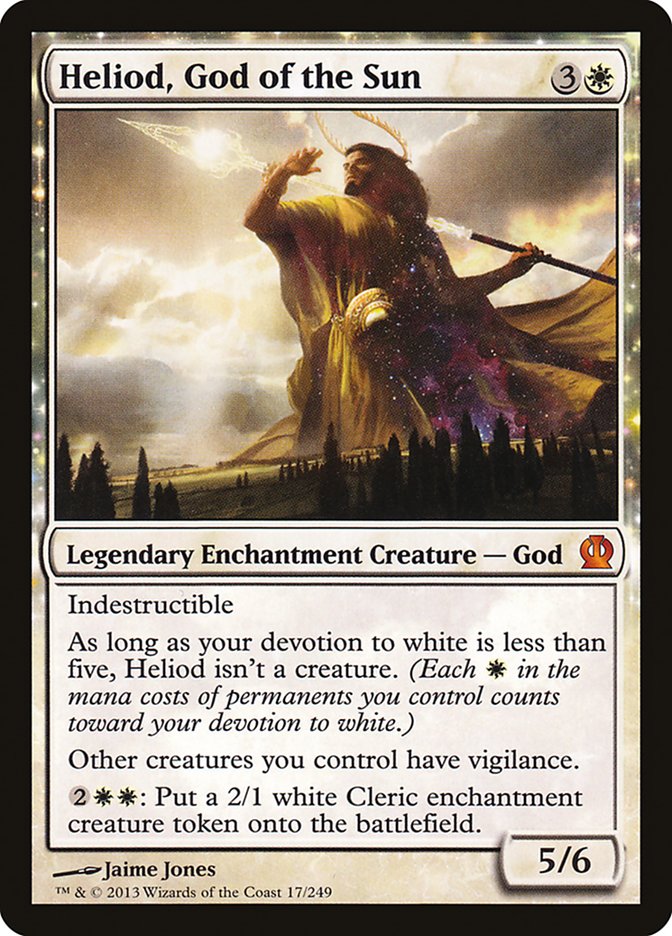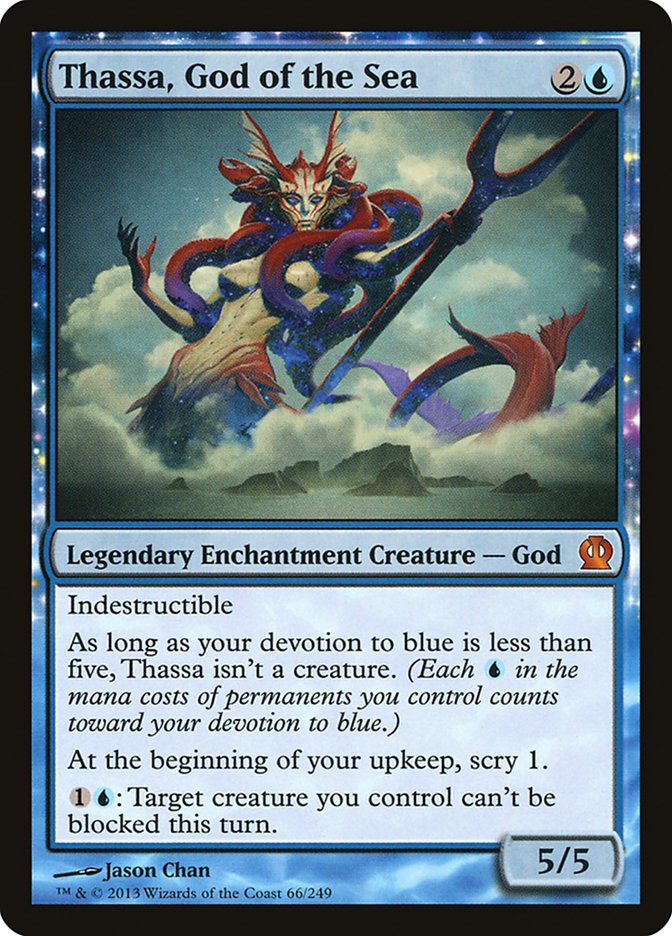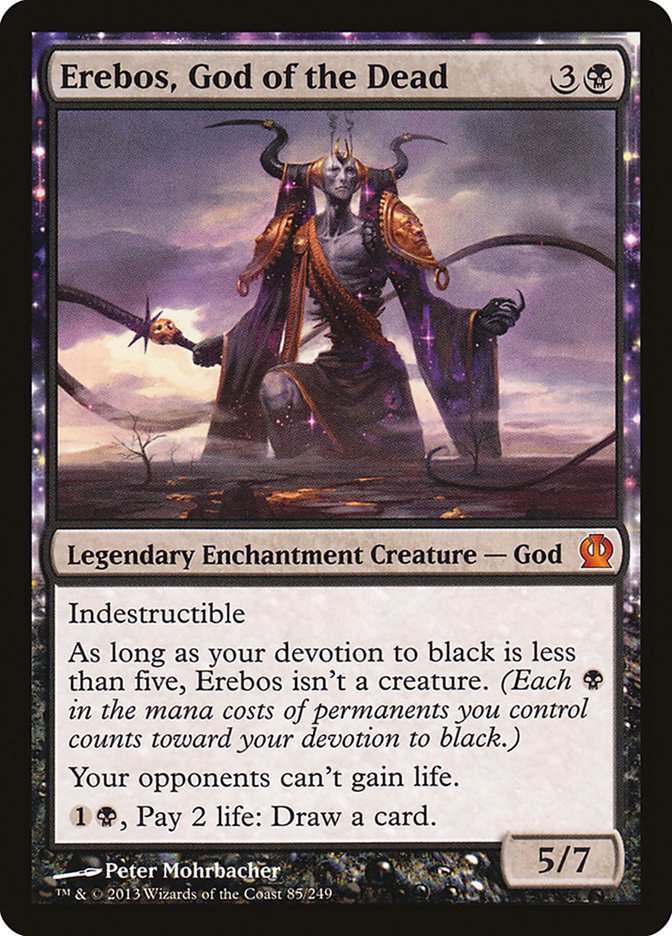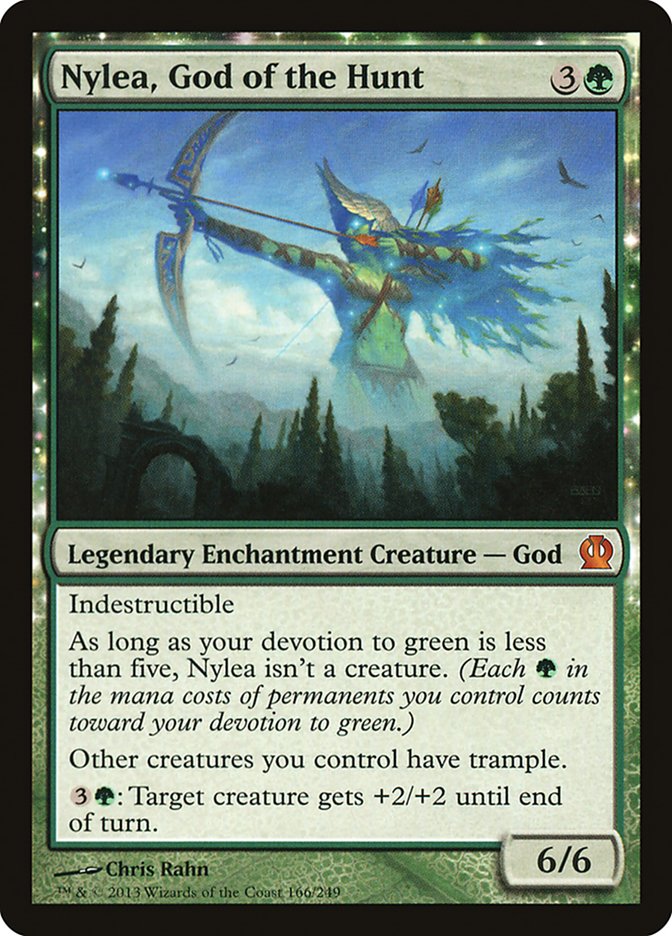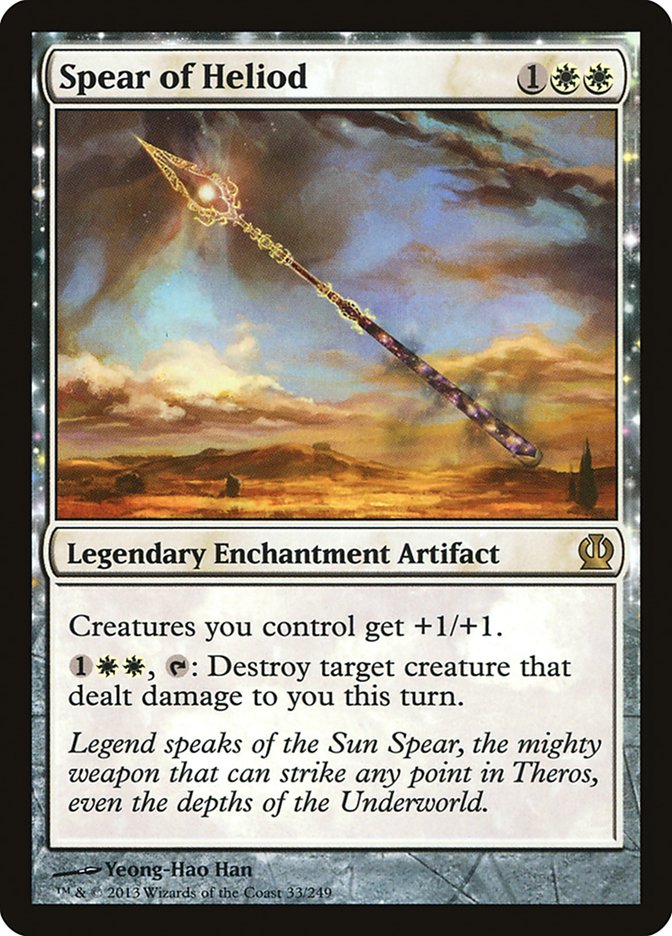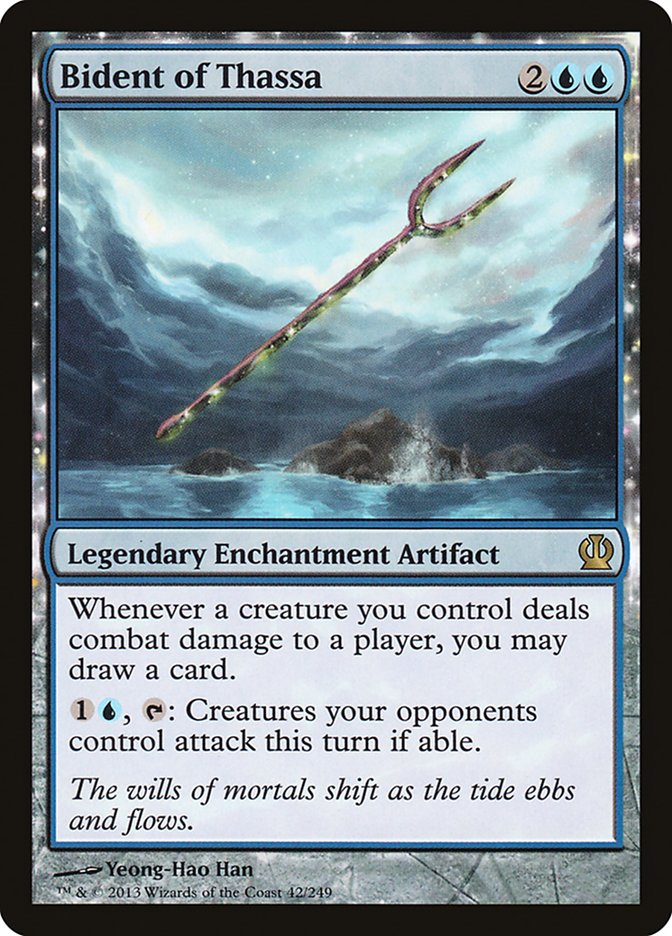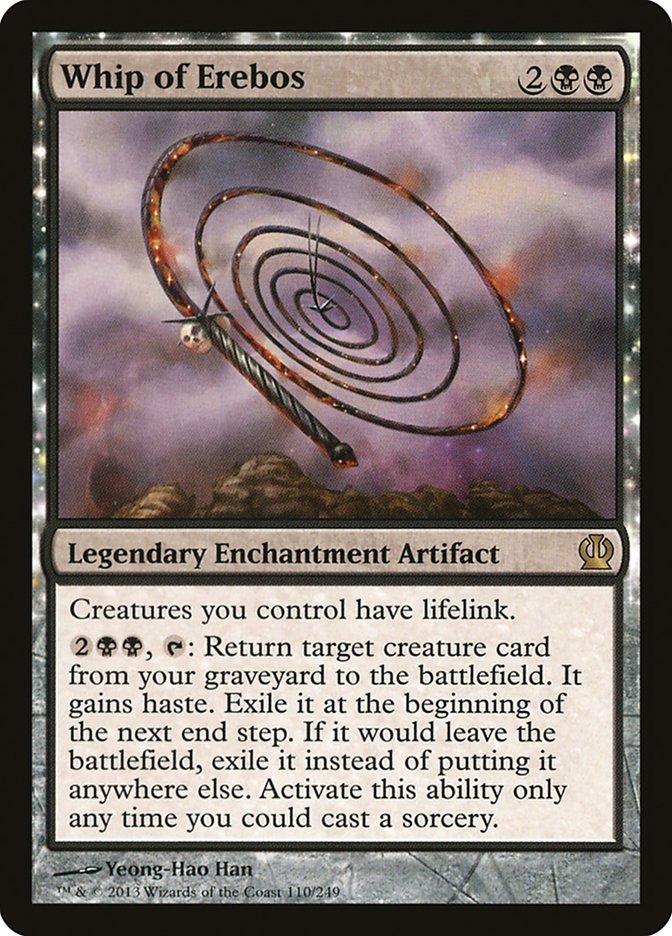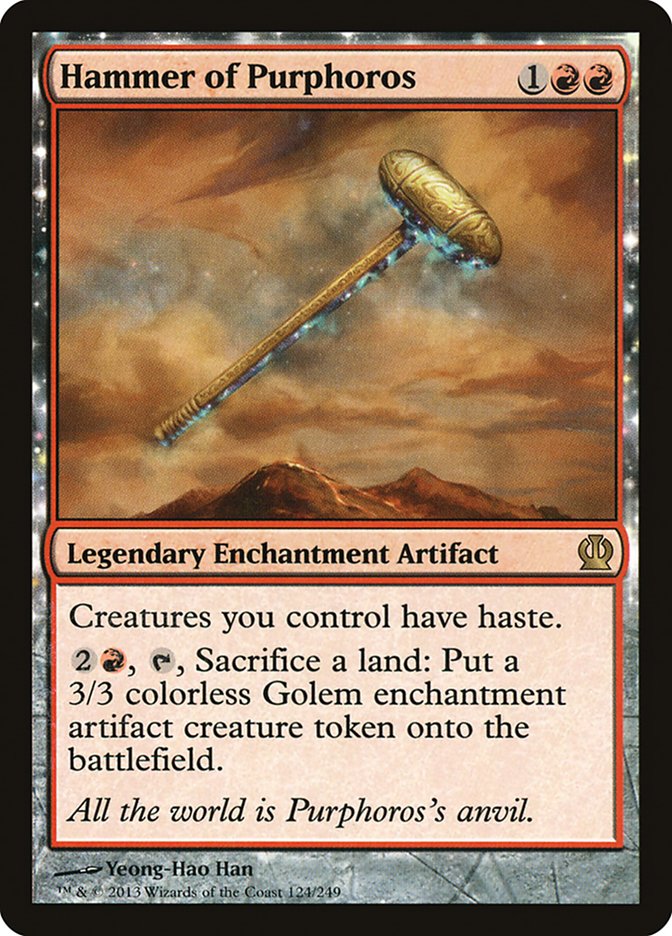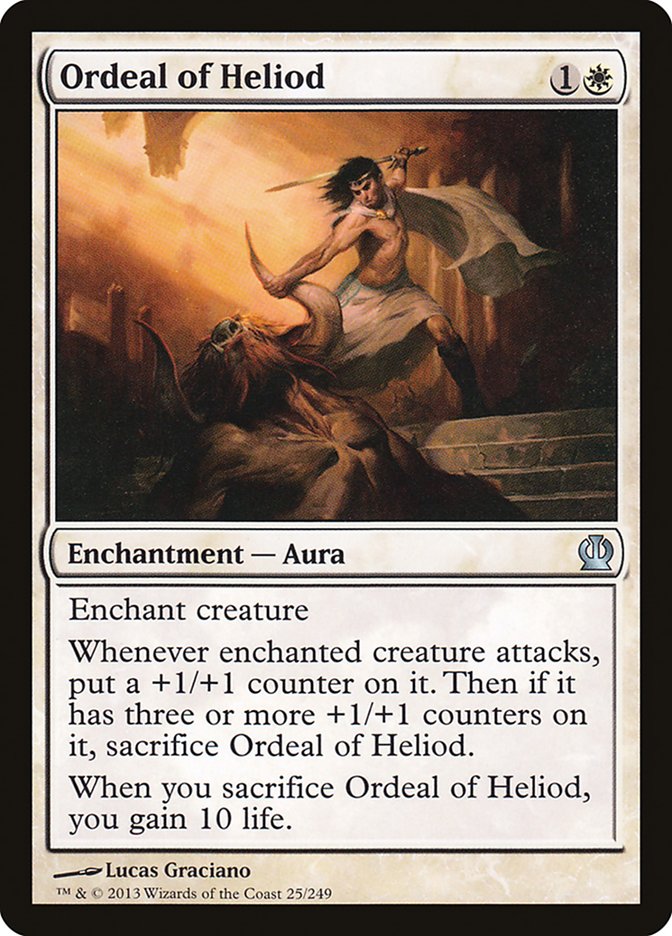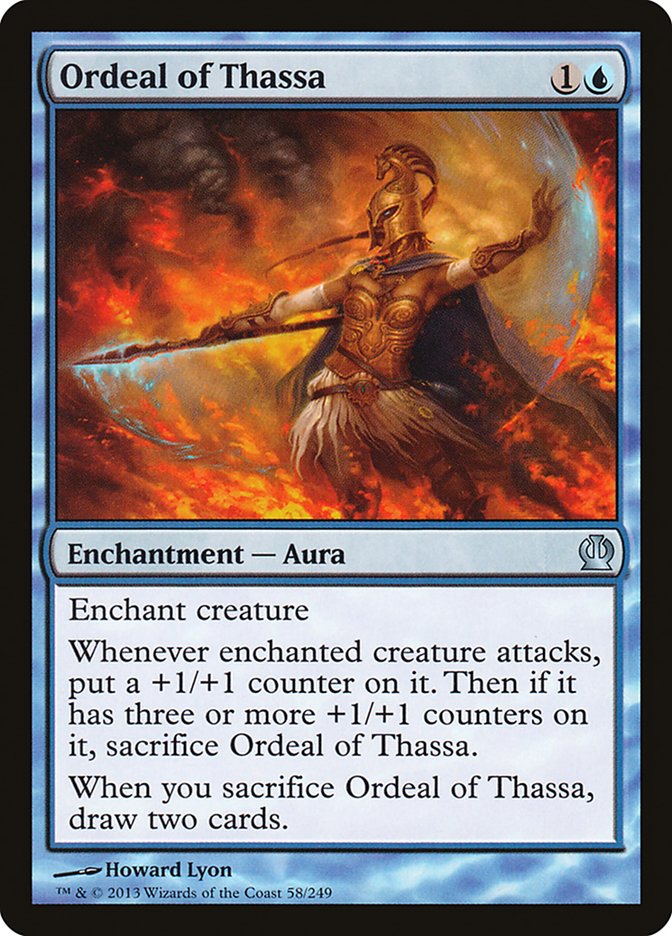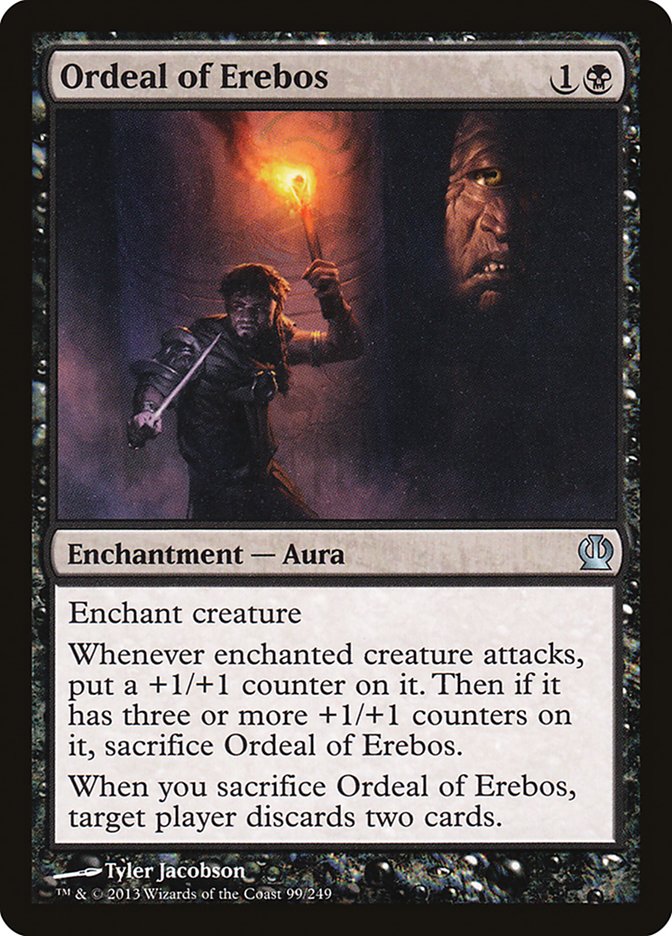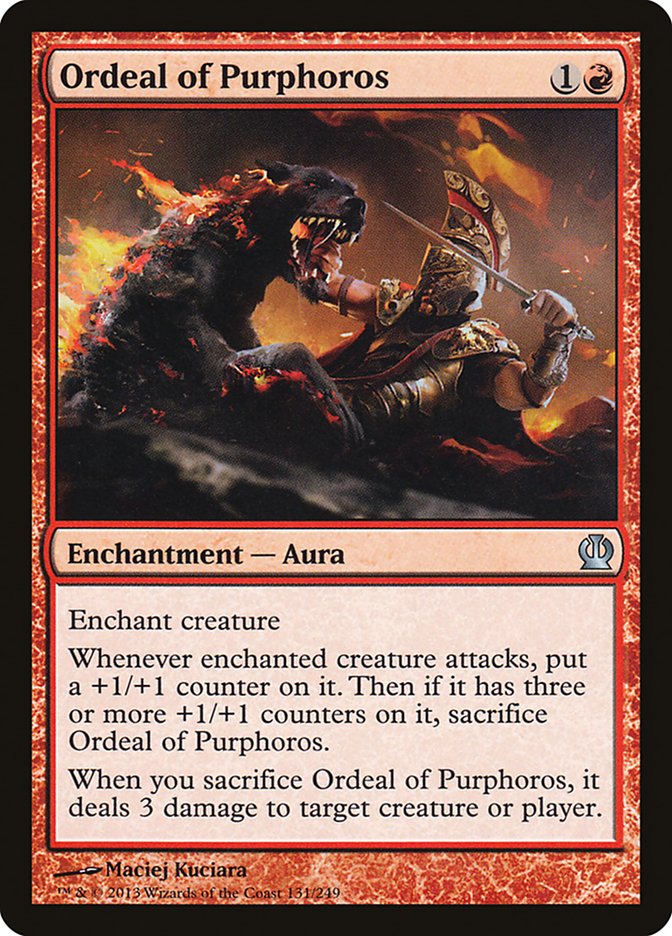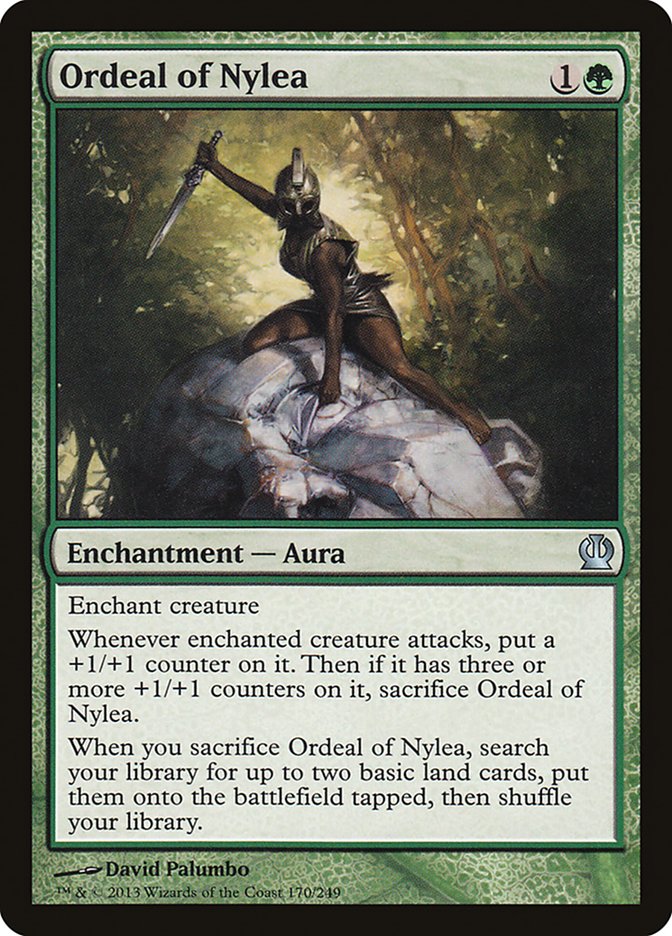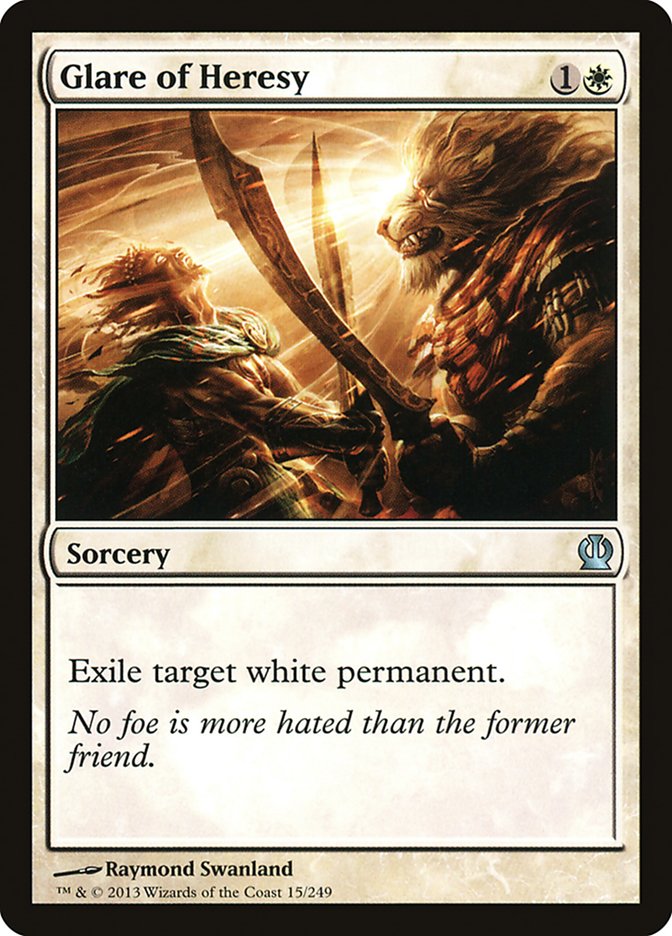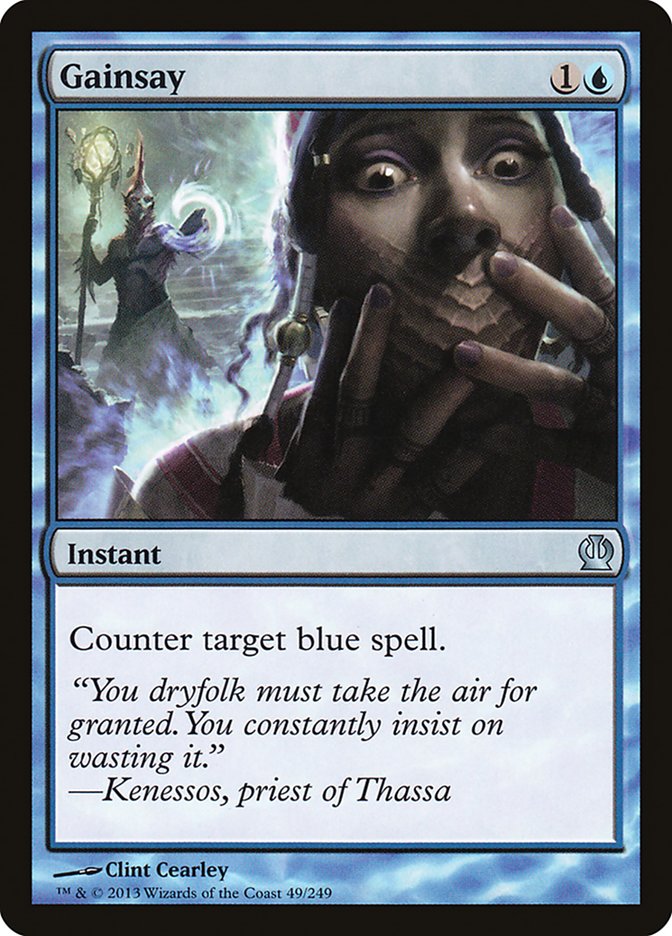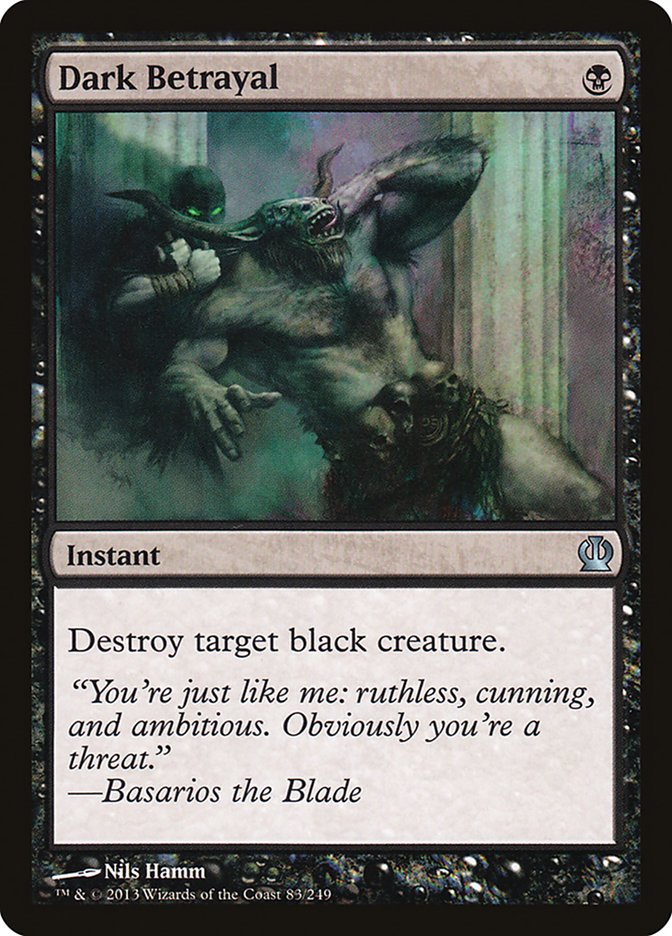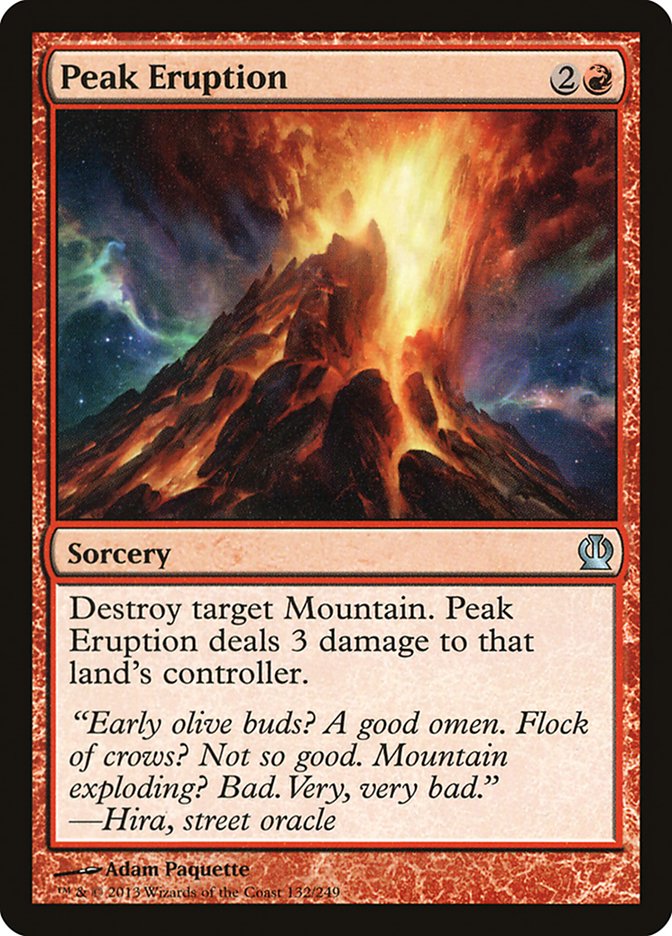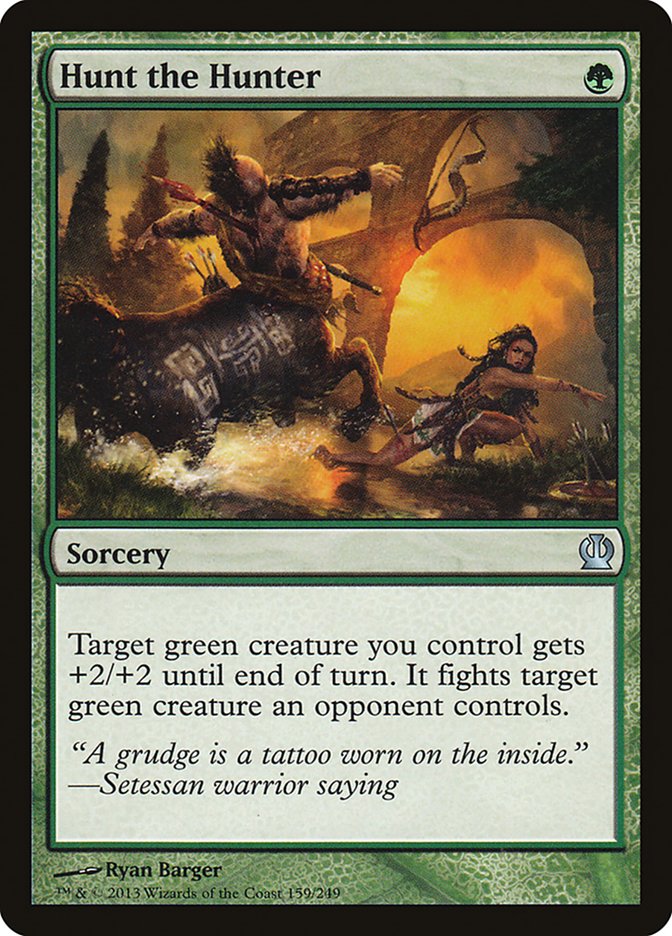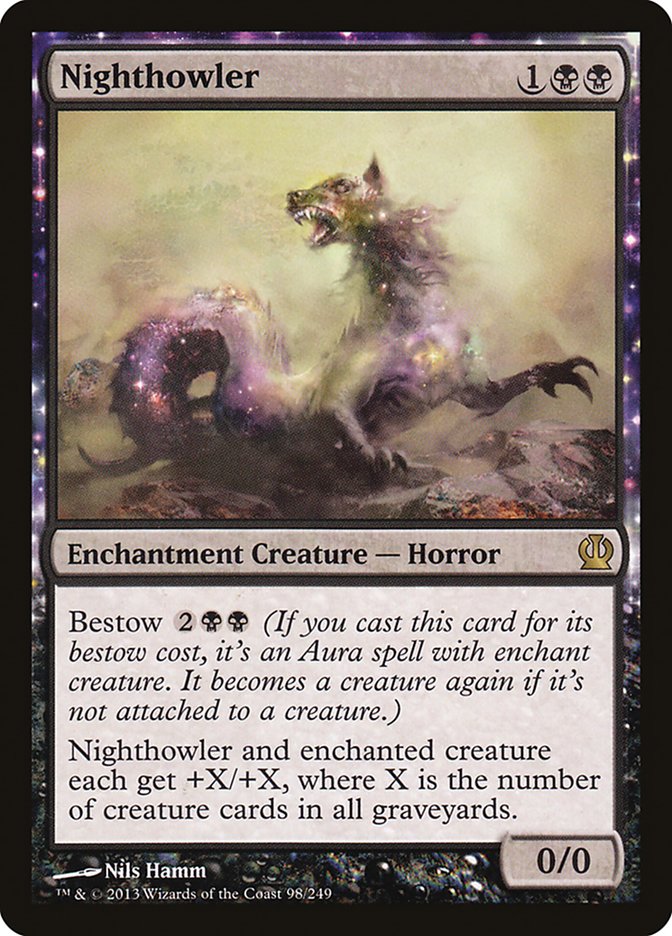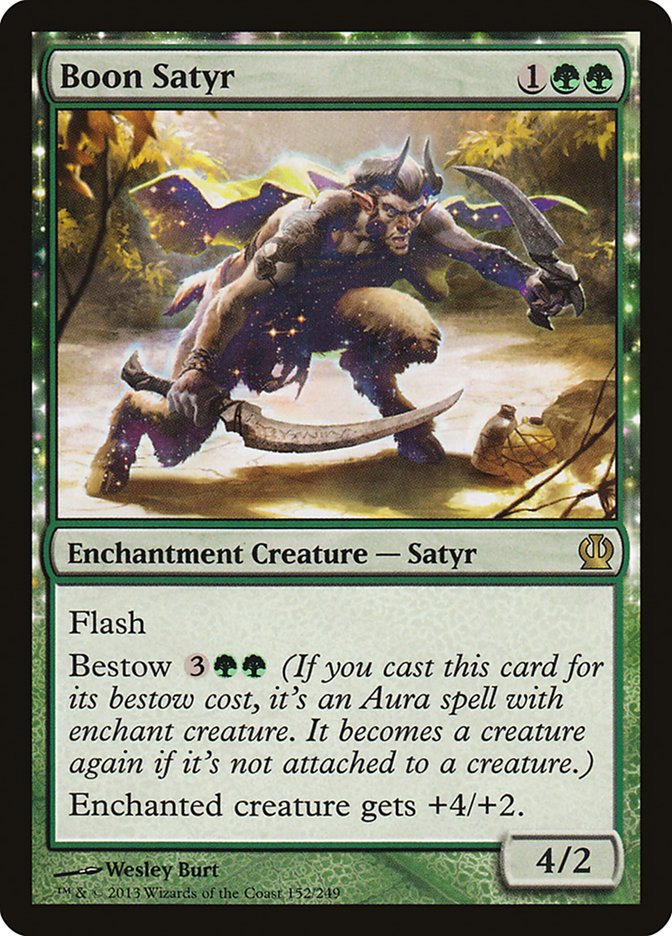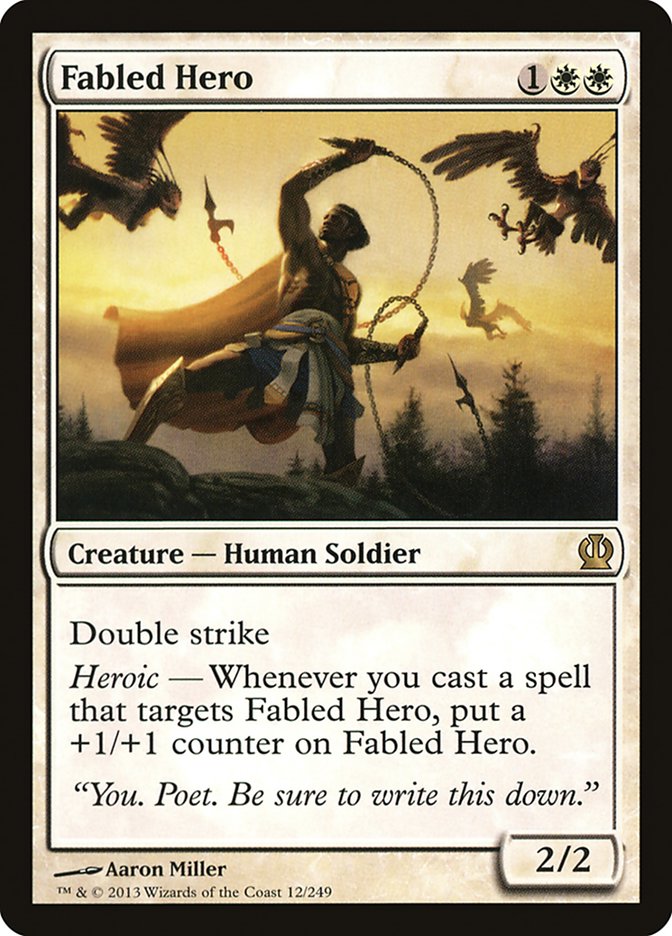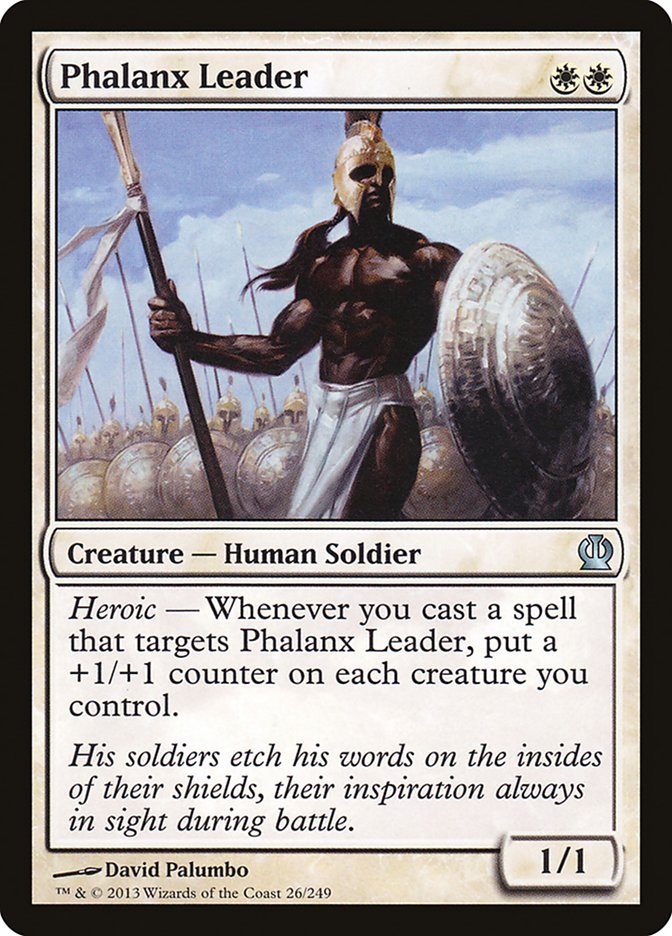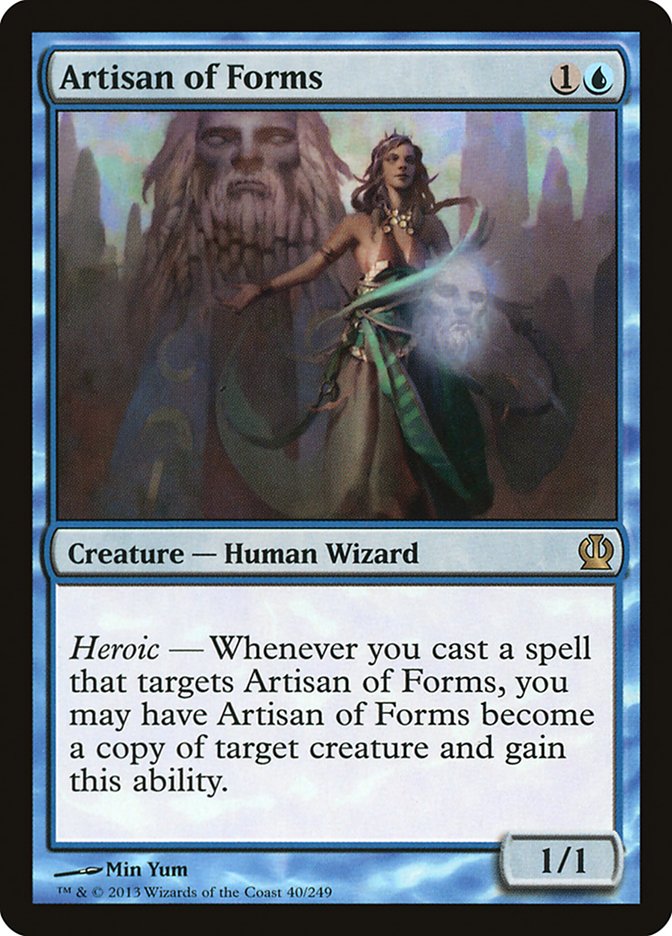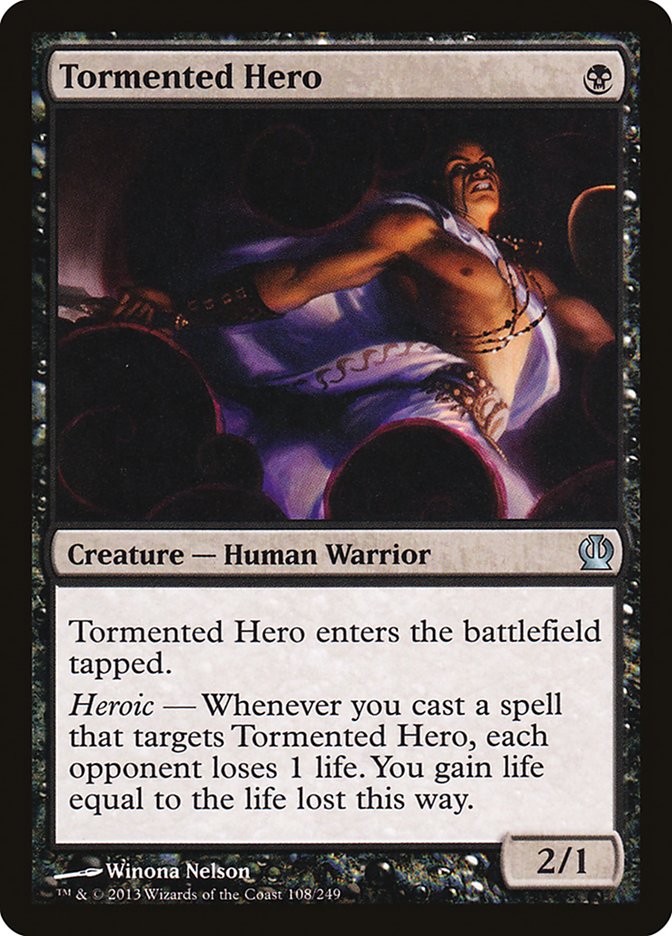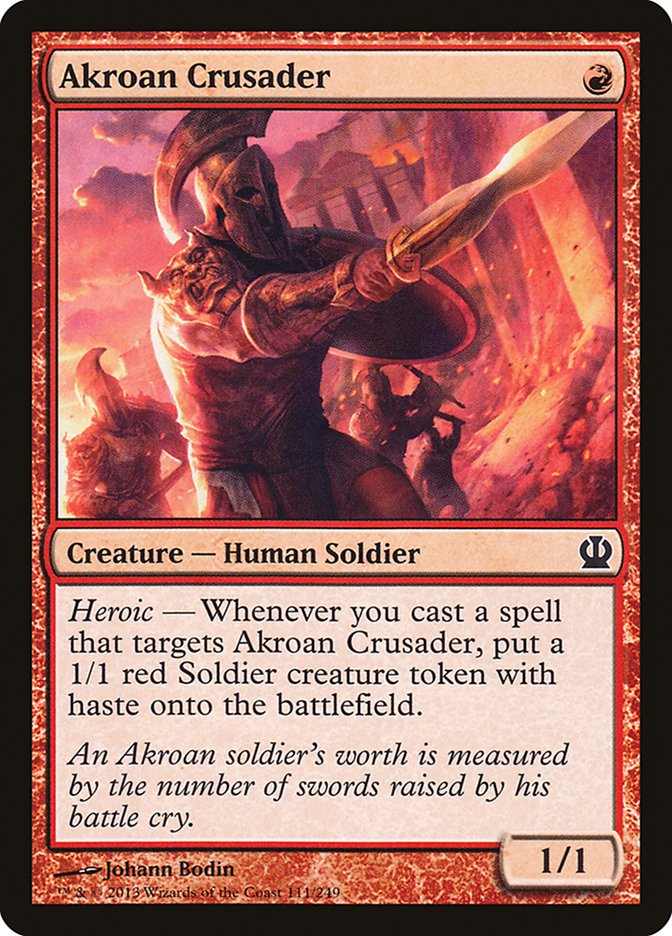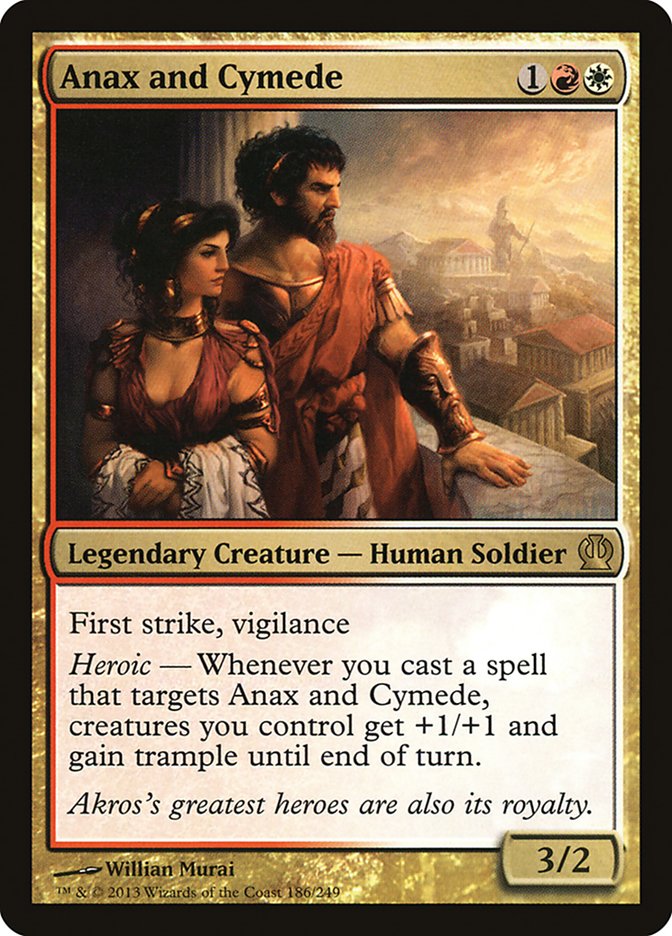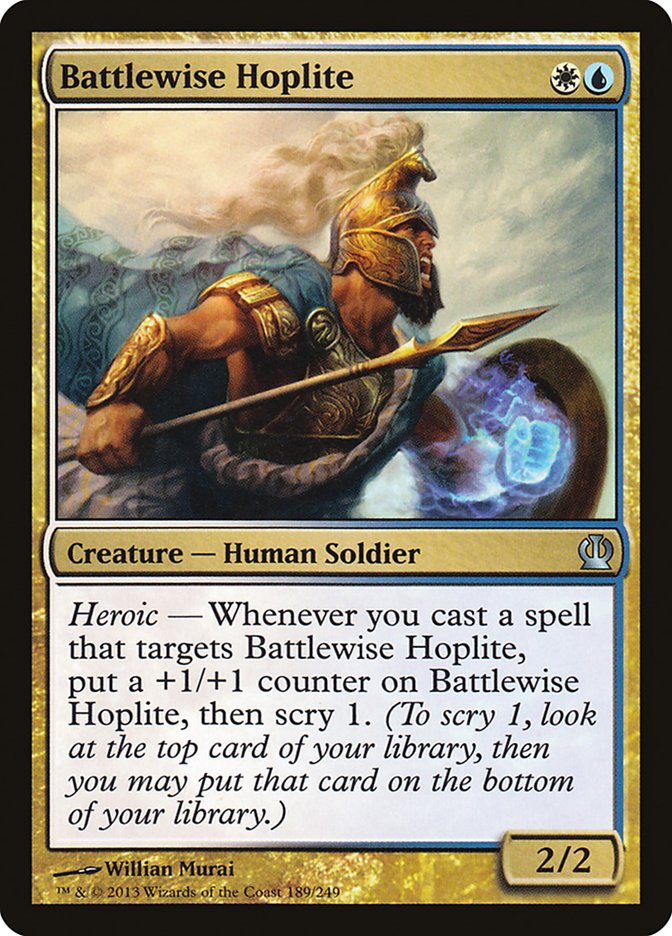Theros is yet another step into the world of creature battles and haymakers. Many of the new quick creatures are heroic. Some of the new haymakers are explicitly Gods, and others are even bigger because they’re monstrous or you’ve had the chance to bestow gifts onto them. All the mechanics in the set reinforce the idea that games are about the clash between various sizes and types of armies in their traditional styles and formations.
The set also oozes flavor. Most of it is good, as disappointed as I am that we couldn’t appropriate more explicitly from the source material due to the need to own the IP on the Gods and other characters. The good parts remind me a lot of Innistrad, with cards that do things that "feel right" without feeling forced. Scry is perfect, monstrosity and bestow feel like they belong while still being natural, and so forth.
The problem is when the set tries to force things that don’t want to happen. Heroic might work out, and the flavor isn’t bad. But it feels like I’m being forced to do something stupid, and some of the cards seem to have a lot of complexity whose sole purpose is to hammer us with how flavorful they are. In a nutshell, Chained to the Rocks bothers me about as much as Peak Eruption makes me happy, Bow of Nylea has way too many words, Hundred-Handed One is "wrong" on multiple levels (or at least by one somewhere!), and Swan Song is pure genius.
In a world like this, cards that do things Magic decks naturally want to do in the creature era and that do those things efficiently will fit right in. Cards that do something that decks do not naturally want to do will have a hard time finding a home. The big question facing Theros is whether it will make those cards attractive enough to let players pursue what might be called "unnatural" strategies alongside more traditional approaches and to what extent all these approaches are equipped to face the control cards that are being carried over from Return to Ravnica block.
When looking at this set, by the way, my new favorite place to do so is here. Spoilers always work best for me in visual form, and by putting similarly themed cards from each color alongside each other, their presentation lets us see how the set is conceptually organized. It’s a great design, especially given how Theros is structured, and I’ll be taking the cycles starting at the top before moving on to the cards that diverge from that pattern. I’ll have scope to do that and then cover the first major mechanic, heroic.
Star ratings are offered on all cards discussed. I don’t try to understand Limited at this stage because I’m epically awful at doing that and my speculations would not be of assistance to anyone. The ratings apply only to Constructed and can be translated as follows:
****: Marquee card in the set, likely a Standard (and/or larger format) staple
***: Solid card that is likely to make it in Standard (and/or larger formats)
**: Fringe card that may or may not ever appear in Standard (and/or larger formats)
*: Weak card that will almost certainly never appear in Standard (and/or larger formats)
Also, the best and most important card in this set is Thoughtseize; it isn’t close, and I really wish it hadn’t happened. I know it was done with eyes open, but the things that card does to Magic are not good and I’m very much not looking forward to dealing with them again. Brian Kibler points on the matter say this better than I can without spending far more space than the issue deserves, but don’t forget that this is by far the most important card in Theros.
The Gods
The Gods are natural cards to build around and obviously powerful, so they’ve gotten a lot of early attention. There are a lot of different upsides available when you play a God, and the key to making a God worthwhile is making it a game winner when it isn’t active. A good mana sink might be exactly what you need when you can’t get enough permanents to put on the table.
Forge[/author]“]Purphoros, God of the [author name="Forge"]Forge[/author] (****) fits the bill nicely. The timing is a little weird since decks that want Purphoros’ effect also want him to be the top end of their curve or at most for there to be a few five-drops, which leads to some awkward choices, but given what your game plan is likely to be you will be reasonably happy to be casting smaller creatures as long as they keep hitting your opponent and can be pumped at will. This then gives the red decks we all know and love another path to victory and the chance to overrun opponents with raw power in longer games. If there’s one sure hit in the set, this is it. Examples of decklists built around him can be found here and here. There’s also the possibility that he could be used as part of a token-generation engine where he’s unlikely to ever become a creature but his other abilities get a chance to shine.
Nylea, God of the Hunt (**) would be so much more appealing to me if she gave herself trample, but she only gives it to other creatures, which makes putting her out using a bunch of mana accelerators that turn her active a lot less exciting. To some extent Nylea is good defense against sweepers since she is indestructible and can hide until you’re ready to attack, but the devotion requirement means that you’ll need a serious amount of commitment and rebuilding to get her active. She’s a terrible choice for the permanent to sneak in after the sweeper, and I find it very hard to justify playing expensive cards that don’t get that job done. The pumping ability is a great bonus but too slow to take over Constructed games for a long time.
Heliod, God of the Sun (*) is the clear dud of the five. Four mana is too much to pay for a 2/1 vigilance creature even with no card cost in a world where the control decks are forced to be active and vigilance is the gold standard for a little throw in that’s nice but not worth any serious price.
Thassa, God of the Sea (***) costs three mana rather than four, so it has by far the best numbers, especially with its implied unblockability. Scry 1 is a very strong passive ability as well. If you get value from unblockability and the cheap body, you likely won’t get maximum value from scry 1, so there are two ways to go about building around Thassa, who is the God most likely to be played without the intention of reliably getting active.
Erebos, God of the Dead (**) doesn’t stand out to me like it does to Kibler. Paying two life per card is very different than paying one life and is often a good way to get yourself killed, especially if you are also playing Thoughtseize or even Dark Prophecy. Tons of opponents will be playing aggressive decks, including a lot of red decks, and will rip you to shreds. Erebos is taking the place of a four-drop that would otherwise help stabilize your game, and instead he’s helping you go on the offensive.
The ability to pay life so aggressively and shutting off the enemy’s ability to gain life are both specialized weapons that are strong against particular opponents but not the kind of thing you want to be building around, so you’re giving up a lot for a card that often won’t do anything for you at all. You can’t play the natural black cards you want and still turn Erebos on reliably the way you can turn on Purphoros.
Underworld Connections is much better and more practical. It effectively costs one mana to activate rather than two and comes down on turn 3 while giving you cards for half of the life cost, which are both big deals. Drawing multiple cards in a turn is great, but that’s four mana and four life, so the price is very steep. I’d stick with the tried and true unless a cheap opportunity to sideboard Erebos in presents itself.
Weapons of the Gods
Spear of Heliod (***) is Glorious Anthem with some serious upside but is a legendary card, so you can’t build around it as you might like to. Abilities that kill creatures after they damage you have proven unworthy as general strategies in the past, but on a three-mana card that would have cost three mana anyway, this is by far the cheapest such an ability has ever been. The high mana cost on activation should mostly keep this away from creatureless control decks, but if I were running a white creature deck that could consider Glorious Anthem, this is a big upgrade from there. The problem will come if all the good, cheap white creatures are heroic since that will leave no room for pumping effects that don’t target.
Bident of Thassa (**) costs a lot of mana. The second ability will usually not do much but will take over games that degenerate into creature stalls, so there’s a bit of one ability being useful when the other one isn’t. Chances are this is out of any realistic price range, but it’s possible.
Whip of Erebos (**) is very expensive. At best it is an interesting specialized tool. If your entire team has lifelink and eventually gets in an additional hit with that lifelink, that’s a huge leg up on the game provided it’s enough to you stay in it while giving up a four-drop, so if certain matchups are structured in the right way, it could work. Most of the time, it’ll be a big investment that doesn’t have enough impact. There’s also the potential to use this on true reanimation style targets, but older formats have better options and newer ones don’t have the necessary supporting cards.
Hammer of Purphoros (****) is being underestimated as a great support card for the big man himself or creature decks in general. That won’t last. The Hammer launches 3/3 haste creatures at your opponent when you’re out of other things to do, in which case you likely have more lands than you need, especially if our curve ends at four or five, and if you have other things to do, such as bring in a God, they now have haste while the Hammer provides two of the four red mana symbols you’ll need.
Sending Purphoros in for six on turn 4 and then churning out 3/3 creatures that attack on the spot and do two damage as well is usually going to be good enough. Burning-Tree Emissary into Forge[/author]“]Purphoros, God of the [author name="Forge"]Forge[/author] is a real threat even on an otherwise empty board. The clash is that if you go this route, you can’t play the traditional quantity of burn that goes into such decks, and you now have multiple three-drops since Boros Reckoner can’t be denied when you’re seeking devotion.
Bow of Nylea (**) is a convoluted mess. The abilities have nothing to do with each other, and none of them are especially good uses of mana. But the threat and option of each has some value, and universal deathtouch on the attack has its charms, especially alongside trample. If there’s a deck where this can mow down a large percentage of the creatures, it would help make the case, although even that ability is more than a little slow. One of this in some places is possible, but no more.
The Ordeals
The Ordeals are turn 2 plays. If you don’t play them on turn 2, there’s no real point. If you do, you can get something going.
Ordeal of Heliod (**) won’t live when you need it most and will live when it doesn’t matter much. Favored Hoplite is the only way this becomes somewhat viable, so you’d need to be all in and then it stops being interesting when the life points don’t matter.
Ordeal of Thassa (**) might be interesting, potentially on Cloudfin Raptor and friends since you can control how long you wait before you collect your bounty, but chances are such decks need to focus on their main goals and can’t risk exposing themselves to a two-for-one like this.
Ordeal of Erebos (**) depends on there being a large number of one-drops that can take this on. Rakdos Cackler is a good start since that gives you a 3/3 and then 4/4, limiting potential answers, and Tormented Hero is another reasonable target. But not being able to spare a mana for Thoughtseize first to set this up is a serious problem.
Ordeal of Purphoros (*) doesn’t do what red decks need it to do. When it finally triggers, it will often not be a big deal.
Ordeal of Nylea (**) is one of the most awkward cards ever made with lots of bizarre tensions. The two ways this possibly makes sense are to trigger it on turn 3 using Experiment One or Cloudfin Raptor or to place it on Elves as an additional mana acceleration option. Getting lands that early is better than drawing more cards, but it will rapidly get worse than Ordeal of Thassa if the trigger has to wait longer than turn 4. Putting this on an Elf is an interesting branch, but can such a deck afford to give up that Elf for that long? Such a thing is doubtful, but perhaps you could sideboard this in and catch some people napping in the right matchup.
The In-Color Hatred
Props to Wizards for putting color hatred into both M14 and Theros that punishes players for all their gold cards without it being blatant that this is what is going on. With Theros poised to have trouble competing with what’s already out there, it’s good to give it any edge you can that doesn’t raise its power level.
Glare of Heresy (**) is a classic effect that is good if that is exactly what you need to spend a slot on, which it usually won’t be.
Gainsay (***) is a reprint that will do its job of both giving blue a good card and making blue worse at the same time. I heartily approve.
Dark Betrayal (**) is priced sufficiently aggressively to be pretty rewarding if you find the right opponent, but I doubt the right opponents will be very common.
Peak Eruption (**) unchains that hero from the rocks! That’s the kind of flavor I can get behind, but it’s likely far too narrow to earn sideboard slots.
Hunt the Hunter (*) is a great concept for a card, but I’d like to see it as an instant that fights up to one target creature even if it has to cost more mana.
Bestow
Bestow is a cool idea, even if the implementation on the cards isn’t ideal, but these cards are priced for Limited. There is only one clearly playable bestow card, and the reason it is playable is it has flash, which gives it far superior optionality that makes up for its price tag. There is also one fringe possibility.
Observant Alseid, Nimbus Naiad, Cavern Lampad, and Spearpoint Oread (*) are way too expensive to consider. Leafcrown Dryad (*) is too expensive to consider, but I wouldn’t quite say way too expensive. That takes care of the cycle. Then there’s Celestial Archon (*), Purphoros’s Emissary (*), Thassa’s Emissary (*), Erebos’s Emissary (*) Nylea’s Emissary (*), and Heliod’s Emissary (*), whose bestow abilities are ludicrously overpriced.
Nighthowler (**) can give you two bursts of Ach! Hans, Run! goodness, perhaps working well with Agent of the Fates. It could be a workaround to the requirement that you pack spells, but it’s also punishing you for packing what spells you do pack. Still, it’s not where you want to be, as it’s more all in on the men in a way that looks like it should reduce your risk but likely doesn’t do that for you.
Hopeful Eidolon (**) offers a two-point life swing and a solid chump blocker on a first-turn play, and its bigger option can still have real impact later on. Neither half is priced to move, but one of these two offers is likely to appeal; if you’re paying four for the enchantment, you’re paying two more than you should be, but often it won’t make any difference.
Boon Satyr (****) is the good one. Four power at instant speed for three mana is often what you want, and the enchantment option being castable at instant speed makes it quite the nightmare for opponents. They have to worry about this responding to a removal spell or as a combat trick to save the target creature, and then when they kill the new big creature, you still get the 4/2 back and get to do that without having to commit your deck to playing an Aura. Suddenly, rather than picking between two overpriced cards that aren’t especially punishing, you’re providing yourself with lots of powerful optionality.
Our Heroes
Heroic is a strange and frustrating mechanic because it pushes cards on me that I don’t want. The last thing I want to do in Magic is target my own creatures with spells. I don’t usually target them with effects at all, but when I do I prefer activated and triggered abilities. Spending spells to target my own creatures is a last resort, especially en masse! The power being offered on many of these cards is quite good, but it’s hard to make the kind of commitment these cards demand in order to be worthwhile. There are a few reusable ways to trigger heroic, but none of them are fun when you take into account the mana requirements.
One solution is to play an Aura-based deck, but there are two problems with this. One is that Theros is an enchantment-based set—or is supposed to be—but its enchantments are pretty bad. I don’t want to waste my spells on such nonsense. Some of the Ordeals rise to the fringe level, but they’re operating on another axis and won’t play well with heroic creatures. Once you start piling on the Auras, you’re committing to putting all your eggs in a few baskets, and the benefits that flow from the heroic triggers don’t save you from your biggest problems. If you’re going to go this type of route, you need to strike quickly before the opponent can react and such that if they don’t act right away, it becomes all right that they extracted some card advantage.
When looking at creatures, it’s always easy to forget the standards you’re competing against, especially if you’re an old-school player, but these heroic creatures have to endure a lot of trials before they can stand up to their opposition. The worst part is that off the top of your deck none of these creatures is a happy draw; once you get out of the first few turns, a lot of them will become very low impact.
One final general note is that I think that heroic should have triggered off anyone’s spells, not only your own, which would have been more flavorful and I believe would have played better as well.
White (They Might Be Heroes)
White’s plan is a good one: make everyone big—really big. It’s too bad that bigger than that is standard issue these days. Things are big!
Fabled Hero (**) is one of the more promising choices because it does four damage for three mana, which isn’t all that bad if it’s left on his own. Most of its competitors aren’t so fortunate, and even one target gets it to six. It’s certainly no Silverblade Paladin, which usually lets you hit for extra damage right away and turns almost any two-drop into a fifth-turn kill on its own; you’d have to target it multiple times to get to that level. You’d go here because you’re going all in on repeatedly being able to target your guys, at which point it is clearly good enough, or because you want a double striker for your pump spells and Auras, at which point it getting bigger is great but is likely a sideshow.
Favored Hoplite’s (**) damage prevention clause makes this card seem like it wants to get targeted with instants, but in order to attack with it on turn 2, you’ll have to take another route. One advantage of the prevention is that it opens the door to an Ordeal, allowing you to safely attack and then attack again, which triggers the secondary effect—a cute trick. You can also target it with your own burn spells safely, although that is quite a waste.
Phalanx Leader (***) is the big splashy "THIS IS THEROS!" heroic guy, and it combines very well with most of the other heroic creatures, especially Akroan Crusader, although the mana there is quite ugly. You’re committing to the targeting plan since it’s useless if you don’t pull it off, and you’re also committing to a swarm plan since you need to be able to take proper advantage. There is no room for half measures, and if you draw either half without the other, you’re leaving yourself quite vulnerable without doing anything that a standard issue control strategy can’t handle. Even if you pull this off, it’s not that different from a properly executed evolve curve, and good Standard decks know how to survive that. It’s impossible not to respect the potential here, but no good player likes what they imagine when they think about the deck this goes into.
Wingsteed Rider (*) has flying instead of double strike, and that’s not going to get it done. Setessan Battle Priest (*) also doesn’t offer anything worth thinking about.
Blue (The Trickster Heroes)
Blue’s plan is to do cool things by targeting its guys. The problem is that getting guys and then targeting them is already conditional, so a conditional thing beyond that is a bridge too far.
Artisan of Forms (**) is a doppelganger that can shift around and use the new legend rules, but now you’re combining three things instead of two, one of which is already there and costs a bunch. You’re not going to want to load up a 1/1 with your best stuff, hoping to change it later into something better by targeting it again.
Triton Fortune Hunter (*) – We used to have three-mana Enchantress effects, but that was a long time ago. Now such effects cost two mana. Compare this to Kor Spiritdancer.
Wavecrash Triton (*) is for Limited and doesn’t provide a payoff worth stacking your cards into.
Black & Red (The Angry Little Heroes)
Tormented Hero (***) gives two power for one mana and is a Human to boot, so it is already going into some decks that have no intention of targeting it at all. If you do have a few ways to usefully target it, that’s even better, and given a way to do so occasionally, you’ll do the last few points in awkward fashion. This seeds the format with a reward for being able to target your own guys, which is cool, and gives Humans a good black one-drop.
Agent of the Fates (***) isn’t as explosive as Phalanx Leader, and the two don’t mix due to a combination of color requirements and the fact that edict effects get worse the more creatures you have to play. But this is heroic in its natural, I want this form. If you kill my creatures, I still didn’t put all my eggs in one basket. Deathtouch is a strong choice for the ability because that means that as an undersized creature it can still trade when it has to and is unlikely to go dead, and if you’re using Auras, you can combine this with either trample or first strike to good effect. Two toughness is perfect because you’re paying for the ability to damage it without killing it but not for extra toughness you don’t want.
Huntmaster of the Fells and Olivia Voldaren would make this guy look foolish, but they’re both rotating out. Edicts are situational, so the ability to turn my removal spell into one in the right situation is pretty awesome. I don’t think this rises to be good enough to get played without eight-plus ways to target it that you’re actively happy about and probably twelve total ways in a pinch, but there’s strong upside here. You can play it in a deck with far fewer creatures than many of your other heroic options, which allows more ways to target.
Akroan Crusader (***) This is very much on plan for red decks and for W/R Phalanx Leader decks if the mana can be made to work, and there aren’t enough quality one-drops to go around without him. But again, you need to be making a serious commitment to targeting it early and often since it’s good but not great if targeted once but pretty great if you can target it twice without giving anything away.
Labyrinth Crusader (*) is a rare that seems to be priced for Limited, which is confusing. Compare this to Guttersnipe.
Green & Gold (The Epic Heroes)
Anthousa, Setessan Hero (*) – Kalonian Hydra showed us what five mana can do offensively a year after Thragtusk showed us a different side of what five mana can do. Arbor Colossus can plausibly compete, but this can’t.
Centaur Battlemaster (*) – Again, the payoff isn’t interesting once you remember what one can accomplish for five mana. You need to target this twice to even begin to break even, and without trample a big win arguably isn’t even possible.
Anax and Cymede (**) – The boost isn’t permanent, and three mana is hefty. It’s simply asking too much to have a three-drop and more guys and targeting methods. You’re competing with Boros Reckoner and with the desire to do your targeting on turn 3 rather than casting more creatures. I’m also confused as to why this is presented as two people.
Battlewise Hoplite (**) is bad but not a complete disaster if you can’t target it. If you do so once, it’s solid, with the scry being a nice bonus, but you’re never going to be thrilled. When I try to imagine what strategy I’m trying to implement by playing this card, I can never come up with a good answer, notwithstanding the details of what cards are out there.
Staunch-Hearted Warrior (*) doesn’t pay off until the third time you target it, which is two times too many.
My conclusion from my analysis so far is that Theros’ biggest impacts will be a new wave of mono-red tools and the return of Thoughtseize, just like everyone else is predicting. There are other cards that matter, many of which I didn’t get to in this article, but mostly they feel like more of the same replacements for individual cards that are rotating out. Those that don’t are going to run smack into the powerful control cards in Return to Ravnica and competition with the aggressive cards in Return to Ravnica, and both are tough to beat. It looks like a real possibility that a lot of players will have decks that don’t include any new cards from Theros.

